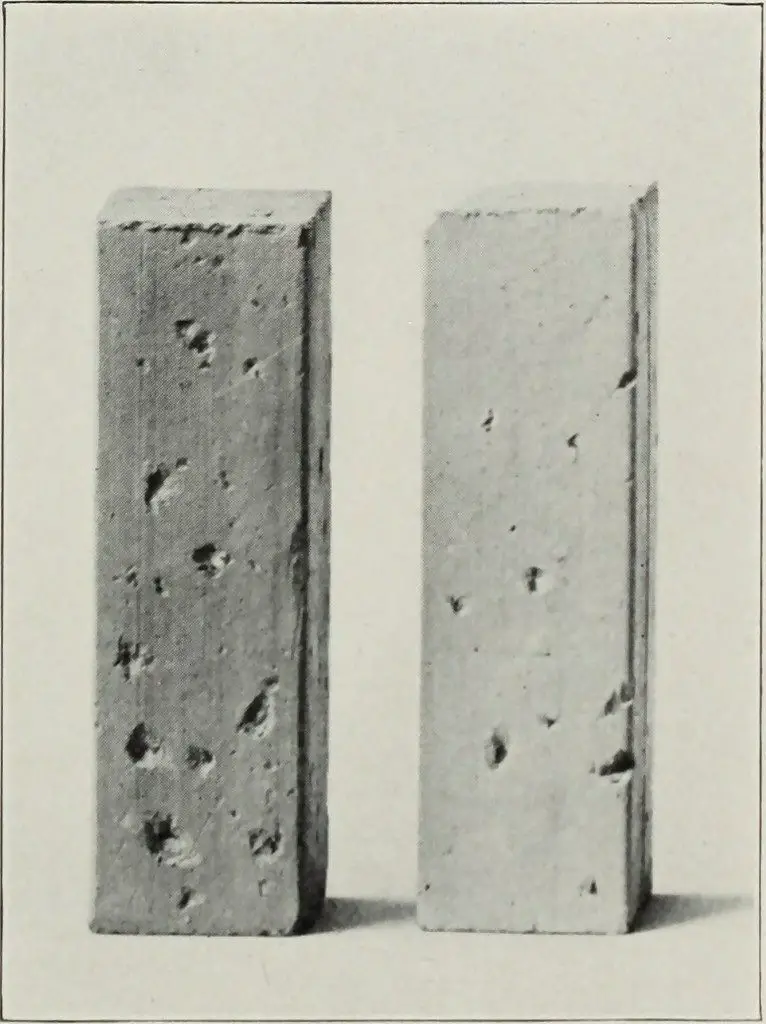 Welcome back to my blog. Get your chair, seat down and relax while you read. But before we talk about anything today, I want to ask you a question. What is the treasure of a potter? I know you are possibly guessing antiques, pottery wheel or a stylus. I hate to break it to you that it is none of your guesses. The greatest treasure to a potter is clay. Just as without steel, a blacksmith is useless, so it is with a potter; without clay, a potter can’t do anything. Clay is one means of promoting creativity. Clay is beneficial to young people – it helps stimulate self-confidence, encourages self-expression and improves problem-solving skills. According to Noam Zimin, founder of Clay Dance Studio, “I believe few art mediums kindle growth and skills in children the way clay does.”
Welcome back to my blog. Get your chair, seat down and relax while you read. But before we talk about anything today, I want to ask you a question. What is the treasure of a potter? I know you are possibly guessing antiques, pottery wheel or a stylus. I hate to break it to you that it is none of your guesses. The greatest treasure to a potter is clay. Just as without steel, a blacksmith is useless, so it is with a potter; without clay, a potter can’t do anything. Clay is one means of promoting creativity. Clay is beneficial to young people – it helps stimulate self-confidence, encourages self-expression and improves problem-solving skills. According to Noam Zimin, founder of Clay Dance Studio, “I believe few art mediums kindle growth and skills in children the way clay does.”
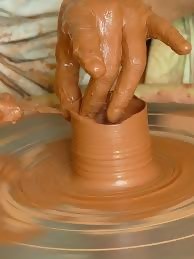 Before we dive into today’s discussion, let’s briefly dig into what clay is, the types and other advantages of clay.
Before we dive into today’s discussion, let’s briefly dig into what clay is, the types and other advantages of clay.
Clay is different from the inelastic soil and fine sand because of its ability. When the clay is wet with the proper amount of water, to form a solid figure and to retain its shape when molded. This quality is said to be the clay’s plasticity. When heated in high temperatures, clay partially melts, resulting in the tight, hard rock-like substance known as a ceramic material. Clay comes from the earth, usually in areas where streams or rivers once flowed. It is made from minerals, plant life, and animals—all the ingredients living above and beneath the soil. Overtime usually about 50years+, water pressure breaks up the remains of flora, fauna, and minerals, pulverizing them into fine particles you use to mold your pots and pans.
Clay minerals such as kaolin, smectite, and palygorskite-sepiolite are part of the world’s most important and useful industrial minerals. It is said that Kaolin is used virtually in every plastic produced in the world today. According to Prof. A.Balasubramanian, Clay minerals are important in several geological applications such as stratigraphic correlations, indicators of environments of deposition and temperature for a generation of hydrocarbons. Consequently, in agriculture, clay minerals are a major component of soil and also determinants of soil properties. The clay minerals are important in construction where they specialize in most brick and tile. The physical and chemical elements of clay minerals determine their utilization in the process industries.
Important Characteristics of Clay:
The important characteristics relating to clay minerals are
- Particle size and shape
- Surface chemistry
- Surface area
- Surface charge
- Other properties are specific to particular applications, including viscosity, color, plasticity, green, dry and fired strength, absorption and adsorption, abrasion and Ph level. In all applications, the clay minerals perform a task and are not just inert constituents of the system.
Types of clay
- Earthenware Clay
- Mid-fire stoneware Clay
- High-fire stoneware Clay.
- Earthenware Clay:
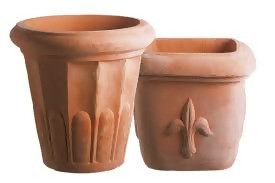 It is otherwise known as or common clay, and it contains many minerals, such as iron oxide (rust), and in its raw state may contain a bit of sand or small bits of rock. Earthenware is a secondary clay that has been transported by stirring water some distance, picking up minerals and other materials before settling in a river bed. Because of its many impurities, earthenware melts at a cooler temperature than other clays. We are going to talk more about this later in this article. Earthenware clay is said to be a low-fire clay because it bakes at a low temperature. It is often used in making terra cotta pots, tiles, and other low-fire ware.
It is otherwise known as or common clay, and it contains many minerals, such as iron oxide (rust), and in its raw state may contain a bit of sand or small bits of rock. Earthenware is a secondary clay that has been transported by stirring water some distance, picking up minerals and other materials before settling in a river bed. Because of its many impurities, earthenware melts at a cooler temperature than other clays. We are going to talk more about this later in this article. Earthenware clay is said to be a low-fire clay because it bakes at a low temperature. It is often used in making terra cotta pots, tiles, and other low-fire ware.
- Mid-fire stoneware Clay
 This is a touch and long-lasting clay that is fired to mid temperatures between 2100 and 2300°F (1205–1260°C). Mid-fire stoneware Clay natural colors vary from light gray to extremely dark gray or chocolate brown. In the 1900s, this type of clay is used to make crocks and jugs. But around the 1950s, potters got creative and started exploring the uses of stoneware clay. They found out that there is more to making jugs and crocks from stoneware clay. It will excite you to know that mid-fire stoneware clay is used to make the ceramic plates you use while dining. Mid-fire stoneware clay is used to make dinnerware.
This is a touch and long-lasting clay that is fired to mid temperatures between 2100 and 2300°F (1205–1260°C). Mid-fire stoneware Clay natural colors vary from light gray to extremely dark gray or chocolate brown. In the 1900s, this type of clay is used to make crocks and jugs. But around the 1950s, potters got creative and started exploring the uses of stoneware clay. They found out that there is more to making jugs and crocks from stoneware clay. It will excite you to know that mid-fire stoneware clay is used to make the ceramic plates you use while dining. Mid-fire stoneware clay is used to make dinnerware.
- High-Fire stoneware clay
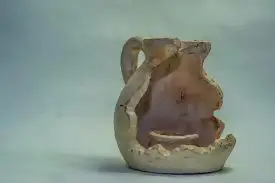 It will thrill you to know that the popular Kaolin you have heard and read is known as High-fire stoneware clay. Yes, Kaolin is another name for High-fire stoneware clay. Kaolin or China clay is the purest form of clay in the world. It is deemed to be the purest clay because it is found very near its source. Kaolin’s particle size is larger than the other two types of clay. You should note that it is not very plastic-like earthenware and mid-fire stoneware clays. This means that if it is in a moist unfired state, it will tear if bent.
It will thrill you to know that the popular Kaolin you have heard and read is known as High-fire stoneware clay. Yes, Kaolin is another name for High-fire stoneware clay. Kaolin or China clay is the purest form of clay in the world. It is deemed to be the purest clay because it is found very near its source. Kaolin’s particle size is larger than the other two types of clay. You should note that it is not very plastic-like earthenware and mid-fire stoneware clays. This means that if it is in a moist unfired state, it will tear if bent.
| TYPE OF CLAY | SUMMARY |
| EARTHENWARE | Known as Common clay, it bakes at low temperature and it is used in the making of terracotta pots and pans. |
| MID-FIRE STONEWARE CLAY | Long-lasting, it is usually grey and it bakes at mid temperatures. It is used in the making of jugs, crocks, and dinner-ware. |
| HIGH-FIRE STONEWARE CLAY | Popularly known as Kaolin/China Clay. It is not very plastic and it bakes at very high temperatures. |
Techniques for using clay
The earliest method of using clay to make bowls and jugs is known as hand-building—using only hands and clay. This approach is still used today. A ball of clay is strained or forced to form a bowl. Or the clay is rolled into ropes or twirls that are then wrapped in mounting circles until the desired height is reached. The coils are then flattened so that they are no longer different. Slab-building is another hand-building method. A large ball of clay is compressed into a pancake-like slab usually about ½ to 2 inches thick. Then the slab is cut into rectangles, which are joined together by wet clay, making the 4 sides of a clay box. To make a bowl from the clay box, the entire slab is then placed over a curved mold.
Enough being said, what happens when you all you have is stiff/hardened clay? Will you just throw it away or decide not to create? How about I teach you step by step how to soften stiff/hardened clay. There are quite a few ways to it and I am going to be showing you step by step how to soften pottery clay.
How to soften air-dry clay
Step 1: Warm the clay with your body heat
Bend the clay, knead it and twist it with your hands hoping to see it revived. The heat and moisture from your hands are enough to bring a ball of air-dry clay back to life (“back to life” I mean moist). Repeat the kneading and bending process for about 5-10 minutes and determine if you are going to proceed to step 2. If the clay is getting soft and loose, just continue bending and kneading with your hands till it gets soft and a moist then place in a plastic bag. but if not, your clay will require more than your body heat.
Step 2: Warm the clay with another heat source: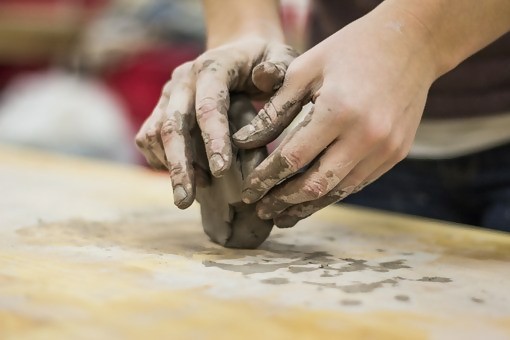 As said earlier, you might need more than your body heat to soften the hardened clay especially if the clay is very hard. You will need to use a heat source to soften the clay. A heat source such as hot water will be relevant in the softening process. You can place the heated water under your clay and allow the clay to absorb the steam from the hot water.
As said earlier, you might need more than your body heat to soften the hardened clay especially if the clay is very hard. You will need to use a heat source to soften the clay. A heat source such as hot water will be relevant in the softening process. You can place the heated water under your clay and allow the clay to absorb the steam from the hot water.
Another heat source you can use is a heat lamp. But make sure the temperature from the heat lamp does not exceed body temperature or else you will be baking the clay which will make it unusable. Alternatively, you can warm your clay in a microwave. Yeah, I know it sounds weird, but you can warm up your clay by placing it in a microwave oven for 10-15 seconds.
Step 3: Roll out your clay
After warming up your clay, the best thing to do is to roll your clay in between your hands in a snake form then roll it into a ball. Rolling helps to create friction which aids the softening process. You can also cut the clay into small pieces before rolling it. The clay may be too hard to roll with your hands; you will need to apply more force. Gently lay the warmed up clay on a cutting board or a slab, then press the clay down on the slab to flatten it as much as you can. After the flattening it on the slab, gently roll out the clay with a rolling pin to make it soft enough. After rolling out with a rolling pin, it should be soft enough to roll with your hands.
Step 4: Hit clay with Mallet
Your clay might need a lot of force to get soft. If rolling and warming up does not work, a mallet will get the job done. You will have to break the clay up into very small pieces, then you will have to place the clay pieces in a sealed plastic bag (air-tight). You can decide to wrap the bag with a cloth and put it on the floor or the cement. After a while, use a rubber mallet to hit on the clay for several minutes. Using the mallet will break up the clay faster and add friction which will make it soften.
ALTERNATIVELY, you can soften the clay by adding Liquid Diluent. Below are the steps
Step 1: Sprinkle Water
After warming the clay with your hands, use your hand or a spray-can to sprinkle water on the air-dry clay. Make sure you don’t sprinkle much water or else, the clay will be sticky and unusable. Then put it in an air-tight bag. If the moist clay is exposed to air, it will get hardened and then you will have to start all over again which might get strenuous. Also, make sure you sprinkle enough but not much water so that the clay can absorb enough moisture to soften. For easier clean-up, you can work with your clay in a sink or tub.
Step 2: Add Liquid Diluent:
Liquid Diluent is a product on amazon that helps in the softening process of stiff/air-dry clay. You can order yours for less than $15 by clicking here. Diluents are manufactured to soften and revive clay, especially polymer clay. You should use liquid diluents if warming up and heating the clay does not work very often and efficient. Add the diluent as you knead the clay, make sure you don’t add too much so as not to make your clay mushy.
Step 3: A bar of clay softener might be needed:
There are clay softeners that come in bar form. Instead of adding liquids diluents, the bars are made of a neutral mixing compound that helps your stiff clay become more feasible. Warm the clay, then complement with the bar clay softener and squeeze until the clay and the clay softener are mixed. Bar clay softeners are often whitish, so you should be careful while using them as they may dilute the color of your clay.
Step 4: Add Liquid Clay:
A reasonable portion of liquid clay may be what your hardened clay is missing to become soft. Liquid clay is another polymer material that can be used to make stiff/hard clay more usable. Use liquid clay in the same way as you would use the liquid diluent.
Step 5: Add petroleum jelly and fresh clay:
Petroleum jelly is a common household product that you can use instead of liquid diluents and clay softeners. Take a small amount of the jelly and rub it on the clay then knead the clay. Another option is to add fresh clay t the hard clay and then knead together, the more the new clay you add, the softer the combined clay becomes.






